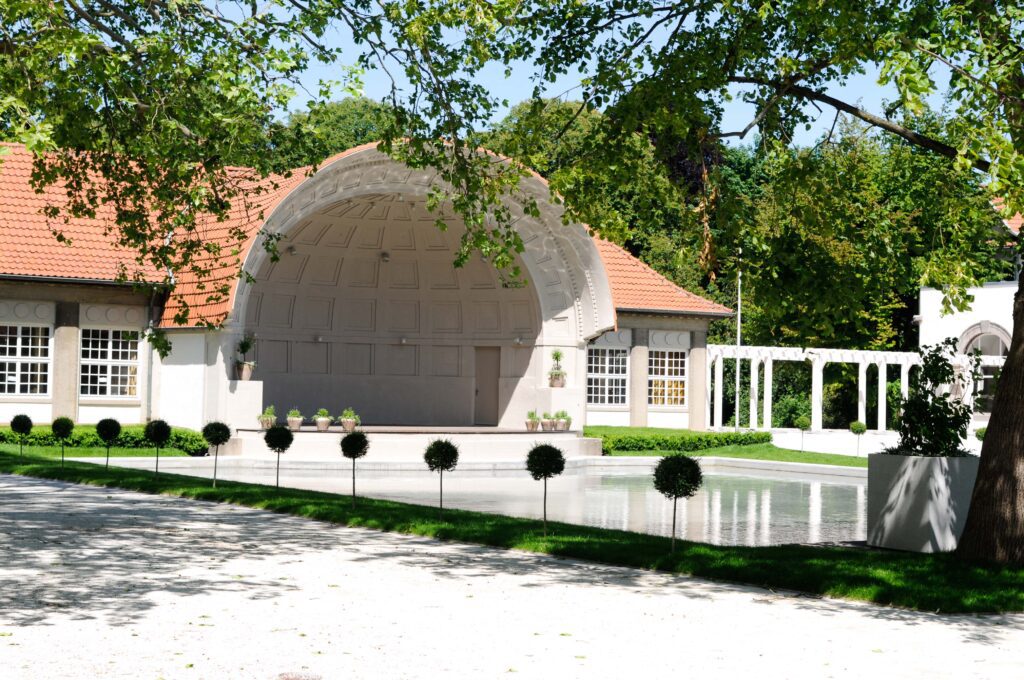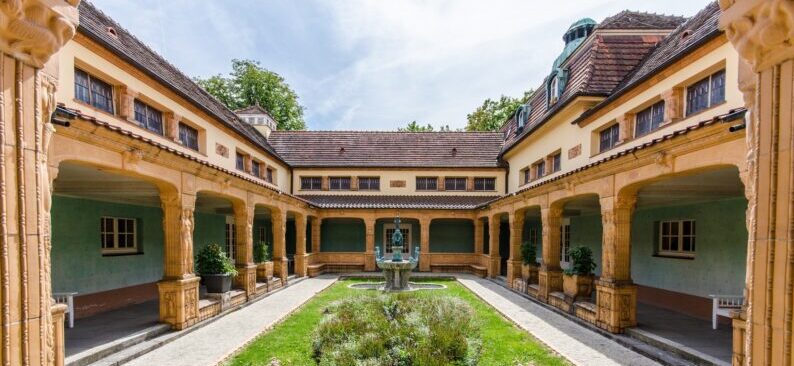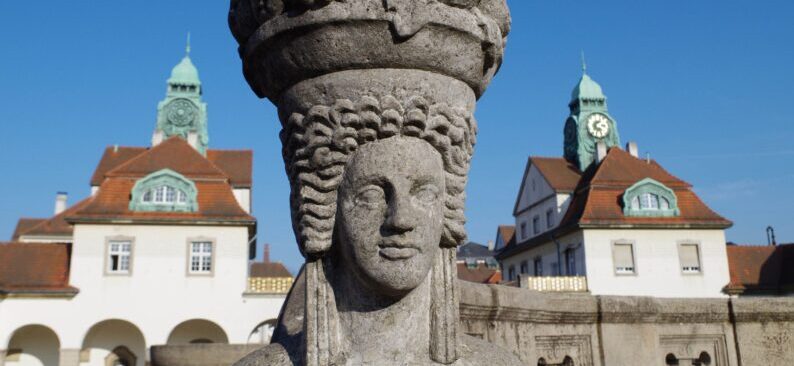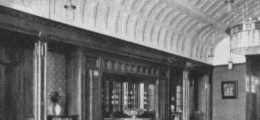The eight cities of Weimar, Chemnitz, Darmstadt, Leipzig, Augsburg, Munich, Nuremberg, and Berlin stand out as the premier Art Nouveau destinations in Germany due to their rich architectural heritage and significant contributions to the Jugendstil movement. Weimar, while best known for the Bauhaus, also boasts beautiful Art Nouveau elements. Structures like the Hansahaus reflect the movement’s aesthetic, showcasing intricate details and innovative designs that exemplify the period’s creativity.
Chemnitz shines with Henry van de Velde’s exquisite Villa Esche, alongside a wealth of preserved Jugendstil residences that offer an intimate glimpse into this artistic era. Darmstadt is particularly noteworthy for the Mathildenhöhe, a former artist colony founded in 1899, which showcases over 1,014 innovative structures that blend Art Nouveau with early modernism. Recognized as a UNESCO World Heritage site in 2021, Mathildenhöhe captures the visionary spirit of its time through masterpieces like the Wedding Tower and the operational Jugendstilbad, immersing visitors in architectural history.
Leipzig contributes to this architectural tapestry with its unique interpretations of Art Nouveau, featuring neighborhoods that showcase numerous Jugendstil buildings, from the intricately detailed Adler Apotheke to the stunning interiors of the New Town Hall. Augsburg, with its blend of neo-Byzantine and Art Nouveau elements in structures like the synagogue and Herz-Jesu Church, enriches the city’s cultural fabric. In Munich, the influential magazine “Die Jugend” catalyzed the spread of the style, resulting in iconic buildings such as the Kammerspiele theater and the Müller’sche Volksbad, primarily found in the artist-rich Schwabing district.
Finally, Nuremberg offers a rare glimpse into Art Nouveau amidst its medieval architecture, with well-preserved examples scattered throughout districts like “Gärten hinter der Veste,” making it an essential stop for lovers of this exquisite architectural style. Berlin, while the last on this list, is a vibrant capital that features a wealth of Art Nouveau buildings, each contributing to the rich narrative of Germany’s Jugendstil movement. Collectively, these cities form a vibrant narrative of Germany’s Art Nouveau movement, each contributing its unique character and history.
Weimar
Weimar, located in the state of Thuringia, is perhaps best known for its connection to the Bauhaus movement, the revolutionary school of art, design, and architecture founded by Walter Gropius in 1919. However, Weimar also has a rich history of Art Nouveau architecture, offering visitors a chance to explore a diverse range of styles. For instance, the main building of the Bauhaus University itself, though primarily known for its modernist influence, bears late Art Nouveau elements in its design, showcasing the transition from one era to another.
One of the most prominent examples of Art Nouveau in Weimar is a striking angular building constructed in 1902 by Henry van de Velde, one of the most important representatives of the Art Nouveau movement. Van de Velde’s architectural works have undergone extensive renovations over the years, ensuring that they remain preserved for future generations to admire. His influence can also be seen in other gems throughout the city, such as the Hansahaus and several beautifully detailed buildings along Humboldtstrasse, Erfurterstrasse, and Cranachstrasse. These structures, adorned with ornamental details, are reminders of the artistic vibrancy that once defined Weimar’s architectural scene.
Chemnitz
Chemnitz, another city shaped by Art Nouveau, owes much of its architectural legacy to Henry van de Velde. His influence in Chemnitz is most evident in the Villa Esche, an extraordinary residence that demonstrates van de Velde’s comprehensive artistic vision. Every detail, from the garden fence to the china used inside the house, was meticulously designed to reflect the Art Nouveau aesthetic. Much of the villa has been carefully preserved, offering visitors an immersive experience of the period’s design philosophy.
Van de Velde also designed two other notable villas in Chemnitz: Villa Körner and Villa Quisisana, both of which still stand as testaments to the elegance and innovation of Art Nouveau. Additionally, the Kaßberg district in Chemnitz is home to one of the largest contiguous Art Nouveau and Wilhelminian quarters in Europe. This sprawling neighborhood, with its well-preserved buildings, offers a unique opportunity to experience the scale and diversity of Art Nouveau architecture in one of Germany’s often-overlooked cities.
Darmstadt
Darmstadt, a city in the state of Hesse, Germany, is renowned for its architectural heritage, especially in the context of Art Nouveau, also known in German as “Jugendstil.” Among its most iconic landmarks is the Russian Chapel of St. Mary Magdalene, standing adjacent to the famous Wedding Tower (“Hochzeitsturm”). Both structures form a striking silhouette and represent the city’s artistic character. The chapel, with its golden domes, was built for the last Russian Tsar, Nicholas II, and showcases stunning Byzantine elements, while the adjacent Wedding Tower, designed by Joseph Maria Olbrich, is an Art Nouveau masterpiece with its unique, angular design.
Darmstadt is celebrated as a bastion of Art Nouveau architecture, and nowhere is this more apparent than at Mathildenhöhe, a former artist colony founded in 1899. Mathildenhöhe is one of the most significant examples of visionary urban design, where architects and artists of the time pioneered work that blurred the lines between Art Nouveau and early modernism. This unique site was recognized by UNESCO in 2021, being added to the World Heritage list for its contribution to architectural history.
The Mathildenhöhe colony originally consisted of 23 artists who designed and built over 1,014 Art Nouveau structures. These buildings, many of which are still preserved, showcase the innovative spirit of the time. In addition to the Wedding Tower, other highlights in Darmstadt include the Jugendstilbad, a historic Art Nouveau-style bathhouse, which is still operational today, allowing visitors to experience a piece of architectural history in an immersive way.
From exhibitions to exclusive tours, Art Nouveau Club covers everything related to Art Nouveau across the world. Visit the Darmstadt page to learn more about Germany’s unique Art Nouveau heritage and its key sites.
Leipzig
For anyone passionate about Art Nouveau, Leipzig is a treasure trove of architectural wonders. The city is home to a vast number of Jugendstil buildings, many of which reflect a more restrained and functional interpretation of the style compared to its more whimsical counterparts in other regions. Art Nouveau structures can be found throughout various neighborhoods, such as Gohlis, Plagwitz, Leutzsch, Stötteritz, and the Waldstraßenviertel, each district offering its own unique examples of this ornate style.
In the heart of Leipzig, Peterstraße and the Adler Apotheke on Hainstraße are well-preserved examples of Art Nouveau’s influence. The intricate details on these buildings, from decorative motifs to ornate window frames, showcase the craftsmanship that defines Jugendstil. Inside Leipzig’s New Town Hall, one can also admire beautiful Art Nouveau elements that have been carefully maintained over the years. The main train station’s ticket halls are another place where visitors can marvel at the Art Nouveau style, making it a delightful experience for those traveling through the city.
Augsburg
Although Augsburg is best known for its Renaissance architecture, the city also has a wealth of Art Nouveau landmarks dating from the late 19th century through to the First World War. One of the most prominent examples is the Augsburg Synagogue, which blends Art Nouveau with neo-Byzantine architectural elements, creating a visually stunning and unique building. The synagogue’s magnificent dome is particularly striking, symbolizing Augsburg’s rich cultural and architectural diversity.
Other important Art Nouveau structures in Augsburg include the city’s swimming pool, as well as the Herz-Jesu Church in Pfersee, which is considered one of the city’s most beautiful Art Nouveau gems. The residential districts of Beethoven and Prinzregenten, along with Augsburg’s garden cities, are also home to numerous Jugendstil buildings, each characterized by their elegant designs and decorative features.
Munich
Munich played a central role in the development of Jugendstil in Germany, particularly after the founding of the illustrated cultural magazine “Die Jugend” in 1896, from which the style takes its German name. Today, numerous buildings across the city bear witness to this once modern, avant-garde movement. Munich’s Kammerspiele theater and the Müller’sche Volksbad are two of the city’s most iconic Art Nouveau structures, both exuding the elegance and charm that defines the style.
In Munich’s Schwabing district, a haven for artists and creatives in the early 20th century, Art Nouveau houses line streets such as Leopoldstrasse, Franz-Joseph-Strasse, and Elisabethenstrasse. One of the most striking examples is located at Ainmillerstraße 22, a colorful building adorned with vibrant arches, designed by Felix Schmidt around 1900. Further noteworthy is the house at Gedonstraße, an architectural masterpiece by Martin Dülfer, one of the leading figures in Jugendstil design.
Nuremberg
Nuremberg may be more famous for its medieval architecture, but the city is also home to some remarkable examples of Art Nouveau. Particularly in the district of “Gärten hinter der Veste,” several Jugendstil buildings have been preserved, forming a cohesive ensemble that survived the aerial bombings of World War II largely intact. The streets of Friedrichstrasse, Archivstrasse, Meuschelstrasse, Bucherstrasse, and Kaulbachstrasse boast buildings adorned with characteristic Art Nouveau decorations, now protected as listed monuments.
Other areas in Nuremberg, such as Galgenhof and St. Leonard, also feature notable Art Nouveau architecture, including buildings along the Prinzregentenufer. These districts offer a glimpse into a lesser-known side of Nuremberg’s architectural heritage, where the organic forms and delicate details of Jugendstil contrast with the city’s more famous medieval landmarks.
Berlin
Berlin, Germany’s vibrant capital, is also home to numerous remarkable examples of Jugendstil (the German term for Art Nouveau), although it is referred to as Art Nouveau in most other countries. The style, characterized by flowing curves and intricate decorations, left its imprint on many buildings in the city. For instance, the Stadtbad Steglitz, a public swimming pool, stands out for its delicate ocean-themed motifs, adding a touch of underwater elegance to its architecture.
In addition to the Stadtbad, the Littenstraße courthouse and the train station at Mexikoplatz are striking examples of Art Nouveau architecture. These buildings, with their intricate façades and curved forms, are emblematic of the Jugendstil movement in Berlin. The Hebbel Theater, a major cultural hub in the city, also reflects the Art Nouveau style, as do other prominent buildings like the Jandorf department store and the Karl Schrader House in the Wedding district.
However, the crown jewel of Berlin’s Jugendstil architecture is undoubtedly the Hackesche Höfe, a complex of interconnected courtyards that showcases the full splendor of the Art Nouveau style. The Hackesche Höfe is famous for its decorative facades, intricate tilework, and flowing design elements, making it one of Berlin’s must-see attractions for architecture enthusiasts.
Some readers mentioned to us Bad Nauheim as an important art nouveau spot in Germany, and they may be right. It is a synthesis of art nouveau / Jugendstil and health.
For this reason, we added this extra chapter to the article, and used a Bad Nauheim pic to illustrate the whole new.
Bad Nauheim
While the cities of Weimar, Chemnitz, and Darmstadt are well-known for their individual architectural masterpieces, the spa town of Bad Nauheim is celebrated for its cohesive and extensive Art Nouveau ensemble. Situated in the state of Hesse, this town is home to what is considered the largest contiguous Art Nouveau complex in all of Europe, a testament to the movement’s fusion of art, architecture, and daily life.
The heart of this heritage is the Sprudelhof, a magnificent spa complex built between 1905 and 1911. Designed by architect Wilhelm Jost and incorporating works by artists from the Mathildenhöhe colony, the Sprudelhof is a “Gesamtkunstwerk”—a total work of art. Every element, from the intricate facades and ornamental courtyards to the furniture and bathhouse fixtures, was meticulously designed in the Art Nouveau style. The six surviving bathhouses, with their stunning ceramic masks, terracotta reliefs, and mosaic patterns, offer visitors an unparalleled glimpse into a time when health and aesthetic beauty were perfectly intertwined.
Beyond the Sprudelhof, Bad Nauheim’s commitment to the style is evident in other prominent landmarks like the Trinkkuranlage (mineral water complex) and the historic Art Nouveau Theater. The town’s rich spa history and its exceptional collection of preserved buildings make it an essential pilgrimage for anyone exploring the German Jugendstil movement. It stands as a vibrant example of how a singular vision can transform an entire town into a living museum of architectural innovation and artistic flair.





